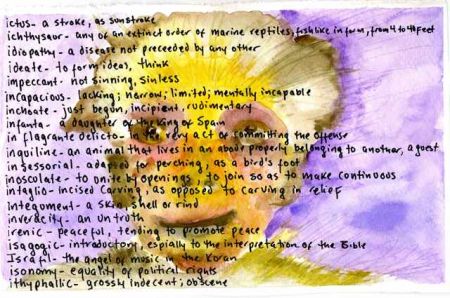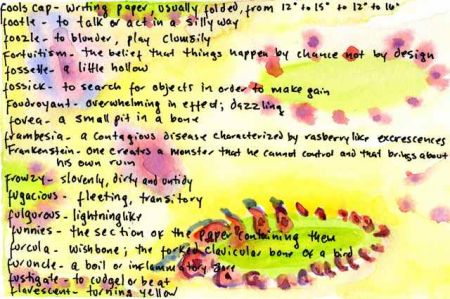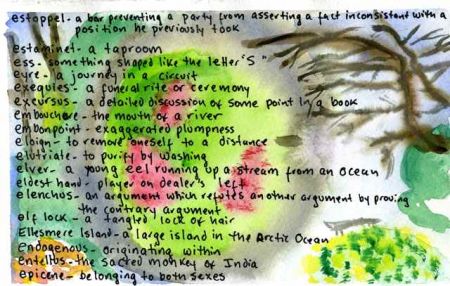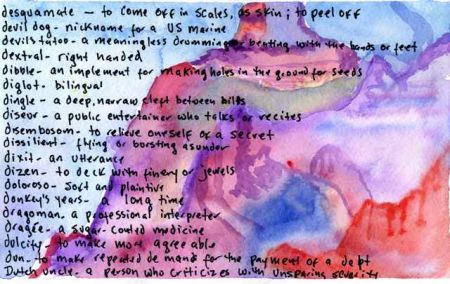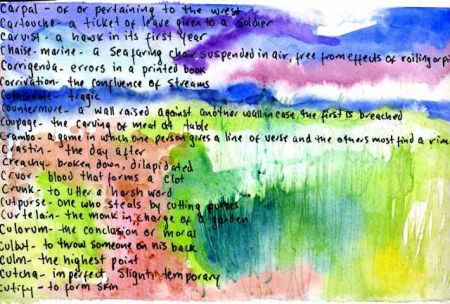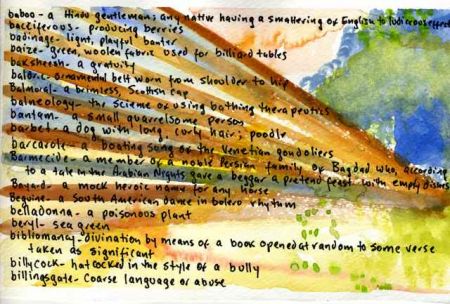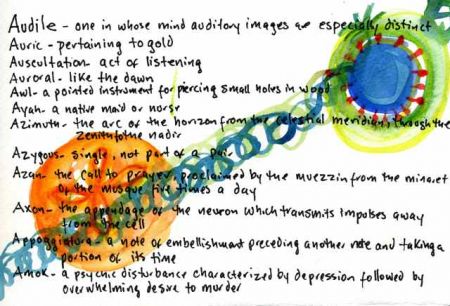Here are some unusual words that begin with the letter I. I painted this watercolor during a cold two weeks in a cabin in the woods at the MacDowell Colony reading the whole dictionary. When I started to think about which one would be right for Abecedarium:NYC, it seemed logical to choose a word that spoke to the experience of living in a home that simultaneously “yours” and someone else’s, namely a landlord. Inquiline fit the bill. It’s really a zoological term we transposed to the the life of a city dweller. Watch Beth Botshon’s video and see what I mean. Which word would you have chosen?
Information
List of G words from 1968 Dictionary
Here is a list of words beginning with G from a forty year old dictionary I pored over during a residency at the MacDowell Colony. It was fascinating and disconcerting to discover how many amazing words have now disappeared not only from our usage but also from this etymological archive. Gone. We chose georgic — which sent me to a community garden in Brooklyn to reflect on agriculture in the city.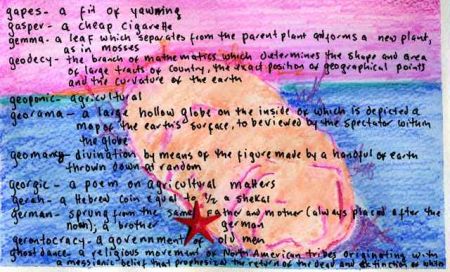
Watercolor of words beginning with the letter F
Here is a watercolor of words beginning with the letter F. I spent two weeks at the MacDowell Colony looking for a list of thought provoking words for every letter. In the end, I chose foudroyant and spent a day at Colony Island shooting people on rides. Which will disappear first Coney Island as we know it or an obscure word like foudroyant?
Intriguing E words from the dictionary.
List of D words from the Dictionary.
Culminant: Watercolor of C words
Bibliomancy: Watercolor of B words from the dictionary
Audile: List of intriguing A words found in dictionary
Here is a list of A words I painted during an artist residency at the MacDowell Colony in New Hampshire in 2006. I spent two amazing, exhausting weeks reading the dictionary, searching for words that intrigued me and that I thought would inspire interesting visual responses. Susan and I chose audile from this list for the Abecedarium:NYC project because it seemed to speak to our auditory sensibilities which at times get ignored in the world of the visual artist.
Open City: Fort Totten, Queens
Fort Totten is the official headquarters of the U.S. Army Reserve’s U.S. 77th Division, the “Statue of Liberty Division”.
Construction began on Fort Totten in 1862 after the land was purchased by the U.S. Government in 1857 from the Willets family. The fort sits on Willets Point, near Bayside in Queens County, New York. The original purpose was to protect the East River approach to New York Harbor, along with Fort Schuyler, which faces it from Throgs Neck on the opposite side of the river entrance. The fort was named in 1898 after Joseph Gilbert Totten.
In 1954, the fort became a Project Nike air defense site. Although no missiles were located at Fort Totten, it was the regional headquarters for the New York area; administrative offices and personnel housing was located at the fort. Fort Totten was also the headquarters for the 66th Anti-Aircraft Missile Battalion, Battery D, whose missiles where located at nearby Fort Slocum on Hart Island. This use of Fort Totten was discontinued in 1974.
Much of the fort has become a public park and is open to the people of NYC for tours by the New York City Department of Parks & Recreation. During the winter months, a large variety of migratory waterfowl can be observed in the surrounding Long Island Sound and Little Neck Bay. Most of the buildings are now run-down and not used. Fort Totten is also a sports complex, as it holds baseball fields and three soccer fields used for youth soccer.
Open City: Fort Tryon Park, Manhattan
“Originally inhabited by the Weckquaesgeek Tribe, who lived in the area until the early 17th century, this densely forested high ground at the northern end of Manhattan was Lang Bergh or Long Hill to the early Dutch colonists. The Continental Army called the strategic series of posts along the Hudson River Fort Washingtonâ€? during the summer of 1776, until Hessian mercenaries fighting for the British forced the troops to retreat. The British then renamed the area for Sir William Tryon (1729-1788), Major General and the last British governor of colonial New York.”
“Containing one of the highest points in Manhattan, Fort Tryon Park towers above the Hudson River, offering magnificent views of the Palisades and the lower Hudson Valley that challenge the notion that Manhattan’s best vistas are experienced from its skyscrapers.”
– from the NYC Department of Parks and Recreation website >>

